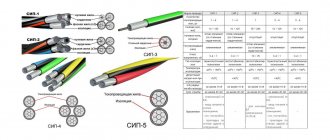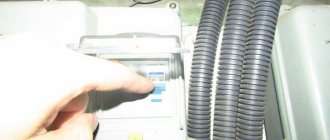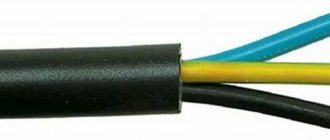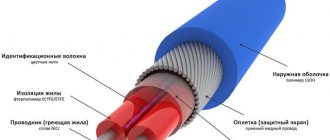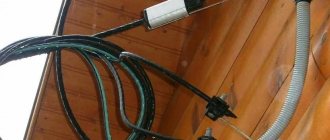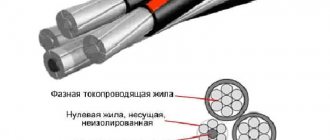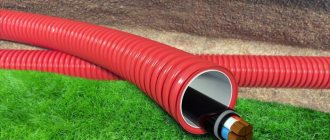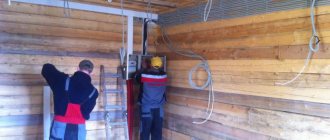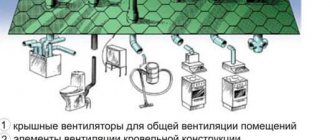With the growing number of energy consumers, SIP wires are effectively replacing conventional bare wires due to their practicality, reliability and safety. Self-supporting wire is widely used in the construction of new power lines, and SIP of four different modifications is also very popular in everyday life. Laying an electrical network using a self-supporting wire allows you to reduce the time it takes to put electrical networks into operation and provide electricity to residential and industrial facilities as quickly as possible. But to carry out installation work yourself, you need to know how to fasten SIPs. Methods for attaching SIP to a pole, types of fasteners, types of self-supporting cables, installation rules, recommendations from specialists when working with SIP will be discussed below.
SIP cable fastenings for various surfaces
Power transmission line wires are the simplest and most inexpensive way to transmit electricity over any distance.
In electrical networks up to 1000 V, power lines are located along the streets of large and small settlements. Insulators with the cheapest aluminum wires are mounted on the supports. And from them branches are already being made into houses. For such branches from main wires, self-supporting wires are widely used.
What are SIPs for?
Self-supporting wires with insulated conductors are abbreviated as SIP, that is, Self-Supporting Insulated Wire. It is a twisted pair and is resistant to longitudinal loads.
Before the advent of this type of wire, compensation of the longitudinal load was assigned to the cable. It served as a support for an insulated wire attached along this cable.
Installation this way took more time and was technically more difficult compared to installing new wires.
Actually, this is the reason they were invented. Now they are used everywhere where, for one reason or another, it is impossible to use cheaper bare wires. Therefore, they are located near buildings and surrounded by trees.
If the wires were exposed, trees, especially in wet, windy weather, could touch them and cause a short circuit. To install SIP, specialized fittings are used.
Its elements are adapted for placement on the walls of houses and supports (pillars).
We make the optimal choice of elements for fastening
The models shown in the images are only a part of what is produced in the world for mounting self-supporting IP.
For this reason, sellers may have in stock products that are actually intended for fastening these wires, but are not optimal for a particular buyer.
When choosing mounting elements, you must take into account the purpose for which the SIP is used. For example, power wires can get hot because they allow conductor temperatures of up to 90 degrees Celsius.
For this reason, an appropriate selection of elements for installation is also necessary.
Facade mounting brackets for such wires should provide a greater distance to the wall for better cooling of the wire.
Experienced electricians who have completed a large number of self-supporting IP installations recommend the widespread brands of SIP with 16 and 25 sq.m. cores. mm secure with a clamp (further in the image).
Clamp for SIP Clamp for SIP This clamp is not recommended for use for SIP-2
There are two reasons for this. Chinese clamps of this model contain a weak bracket that breaks, and as a result the wire can come off.
Another drawback of this model, even if it is not made in China but from a well-known brand, is that the wire cores after the clamp are located too close to the bracket.
Therefore, it is inconvenient to carry out installation work. Especially with facade mounting.
Clamp bracket and where it breaks (fingers touch them) Anchor bracket model recommended for general use The image above shows an inexpensive and convenient anchor bracket. This is fair because you only need one tape to mount it on a pole. It can also be mounted on the wall of a house with just one hardware fastener.
The strength of such connections is sufficient for most situations involving the installation of self-supporting IPs both on poles and on walls.
Therefore, it makes no sense to use more massive, expensive and difficult to install bracket models.
Composition of reinforcement
Since supports for self-supporting IPs come in different designs, part of the reinforcement for mounting to these supports is also selected according to it. The reinforcement and the SIP itself together form a chain. It starts at the support and ends at the wall of the house. The first link is the brackets, which are located on wooden, steel and reinforced concrete pillars.
The bracket holds the next link - the anchor clamp. Then intermediate supporting clamps follow from the reinforcement elements. And this reinforcing chain ends with fastening on the facade of the building (wall). This is the so-called facade fastening.
Bracket Varieties of brackets for self-supporting IP Anchor clamp for SIP Another anchor clamp Another anchor clamp Another anchor clamp Another anchor clamp Another anchor clamp for SIP Anchor clamp Types of anchor clamps for SIP Intermediate clamps Varieties of intermediate clamps for self-supporting IP Varieties of façade fastenings for SIP
Important installation details
- You cannot use one anchor bracket for two self-supporting IP clamps. The force from the wire should be applied most coaxially to the bracket. The force component directed to the side will have a destructive effect on the bracket. One SIP wire – one bracket. This rule cannot be broken.
- If it is impossible to avoid the lateral force in the bracket, it is recommended to use a special model of it with attachment at three or four points located at the corners of the base of an imaginary pyramid, at the top of which is the point of contact between the bracket and the clamp.
An example of a bracket model recommended for self-supporting IP, attached at an angle to it
- For mounting tape on poles, it is recommended to use brackets that have large limiting projections to hold it.
Over time, play appears, which is caused by stretching of the tape. If the protrusions are small, the bracket may come off the mounting location. - On straight sections it is recommended to use support clamps. They are generally cheaper because their design is simpler than anchor ones. But on straight sections this is enough.
- To mount the anchor clamp on the wall of the house, select a place protected from falling snow and icicles.
- Installation of SIP is done taking into account the distances that must be observed.
If the wall of the house on which the anchor bracket is attached is more than 25 meters away from the pillar, self-supporting IP requires additional intermediate support. - The distance from the ground surface to the bracket is 2.5 meters or more, and on the street to the wire between the supports - 5–6 m.
Distances that must be observed when connecting self-supporting IP wires
- Distances to windows, balconies and roofs are also standardized. They are clearly shown in the image below.
Distances that must be observed for SIP if the wire is laid along the wall of a residential building.
There must be at least 6 cm from the wire to it
The images above do not show another distance that must be observed. If the wire is located at an angle to the wall, and the bracket is attached to it closer than 10 centimeters to the corner of the house, over time, especially if the wall is brick, it will crack and the bracket will fall out. It is recommended to mount the bracket to any wall using self-tapping screws with a hex head. The diameter of the screw is selected no less than for the mounting hole in the bracket.
- Gas and water pipelines must also remain at a distance from self-supporting IP pipes laid along the wall by 0.4 and 0.1 meters, respectively.
- If the wall of the house is wooden, the wire is laid along the wall in a metal corrugation. But at the same time, the temperature of the cores must be predicted and, if it is higher than normal, it is necessary to use SIP with an increased cross-section of the cores.
Self-supporting IP on a concrete rectangular pole SIP on a concrete round pole Self-supporting IP on a wooden support Mounting SIP (3 phases and zero) on a brick wall Mounting self-supporting IP on a wooden wall
We start dancing from the façade wall
First of all, you need to select a point on the wall from which the branch will begin. The rules for electrical installations do not regulate the choice of wall: it can be front or side. But in practice, in our latitudes it is the façade that is chosen. Roof slopes usually extend onto the side walls of buildings, from which ice (icicles) or snow can fall off.
The starting point for laying on the wall is considered to be the point where the cable exits the anchor clamp. The main design elements are shown in the illustration:
- Anchor bracket.
- An anchor clamp, after which the wire is not held on the overhead line route.
- Facade fastening is the first element of the wall installation system.
The bracket is installed at a height of at least 2.75 meters. The distance to the nearest corner of the load-bearing wall (excluding the thickness of the insulating material) is at least 10 cm.
Tip: If the cross-section of the power cable allows you to choose between different anchors, you should choose a hanger with a lower load. In this case, if there is a mechanical impact on the SIP (for example, caught by a truck on the road, or a pole falls), the wall will not be destroyed, the anchor will simply be torn off.
Material
Before installation, you must purchase all the material, namely:
- ⚡SIP 4*16 or SIP 2*16 (depending on the input 220V or 380V)
- ⚡Bandage tape SOT37 ~ 2.5-3m (for attaching the hook to the support)
- ⚡SOT36 clamp – 2 pcs (tape fixation)
- ⚡Bandage hook SOT39 or SOT29 – 1 piece
- ⚡Wall hook SOT28 or SOT76 – 1 piece and mounting
- anchor bolts to it
- ⚡Anchor clamp SO80 or SO158 – 2 pcs
- ⚡Puncture clamps SLIP12.1 – 8 pcs (for 380V input) and 4 pcs (for 220V input)
The brands of materials from the manufacturer ENSTO are indicated here; in your case, the specification (SLIP, SO, SOT, etc.) may not be the same, but the names themselves (piercing clamp, anchor clamp, clamp) should be the same.
Before starting work, it will be necessary to take certain measurements. The distance from the support to the facade of the house where the wall hook will be located should be no more than 25 m. Otherwise, you will have to install an additional support support.
Choose SIP depending on what input you will be installing into the house - 220V or 380V. When purchasing SIP, it is better to make some reserve in footage for all sorts of unforeseen situations. Basically, the 4*16 SIP brand is used for entering the house.
Tingle clamps will be required to connect to the main power line. Their choice is very large, there are even some that can be used without removing the voltage from the power lines. The shear head of the bolt is isolated from the contacts. First of all, pay attention to the cross-section of the wire and select the brand of clamp for it.
It is important to make one note.
If the main overhead line to your house is made of bare, uninsulated wires, then the clamps must be appropriate. One side for contacts has a smooth surface, the other has teeth. When there is also an SIP hanging on the main power line, in this case, choose clamps with piercing teeth on both sides of the contact substrate.
clamp for connecting to bare wires
Two hooks are installed on the support and facade of the house. It is between them that the SIP is stretched. Its fixation is carried out with anchor tension clamps.
Installation of SIP wire: fastening, connecting the house to the electrical network
Insulated wires have long replaced traditional ones. They are connected to the building and laid out on supports. This line is called VLI. Often a self-supporting insulated wire is called a cable, which in principle is also true.
The use of insulated wires is convenient because it reduces the risk of electric shock to a person if the line breaks, and also eliminates the possibility of electricity theft.
The SIP wire is installed in accordance with the instructions and technological maps.
Rules and procedure for the construction of VLI
The construction of overhead lines is carried out by a specially trained team of electricians. Installation begins with preparatory work, including clearing the route from vegetation and other obstacles.
Before rolling out the wires, all supports must be installed, passages through engineering structures must be protected, and, of course, drums with the wire itself must be delivered.
If VLI is supposed to supply electricity to the house, anchors must be installed on the building in advance for hanging SIP wires.
Installation of the drum and auxiliary mechanisms
Wire rolling begins by installing the drum. It is placed near the support where the final adjustment of the booms will be made. Moreover, the optimal distance between them is considered equal to the height of the support itself.
For manual rolling of wires, a special leader rope is used. This is a kind of synthetic cable with a length of 30 to 50 m and a diameter of 10 mm. The rolling out of the rope is carried out simultaneously with the fastening of the rollers and intermediate hangers on the supports. As the rope rises, the intermediate suspension is fixed to the pole with a special metal tape. If the support is equipped with a hole, the suspension can be secured using a bolted connection.
The intermediate suspension bracket is equipped with a hole. The rolling roller is attached here. The number of hangers and rollers depends on the number of complex pillars, intermediate, corner and anchor supports. It is important to maintain the correct position of the rollers so that the axis of the cable being laid is at the level of the recess of the support clamp.
The videos have some differences.
- The RT 5 mechanism is installed on complex and anchor poles. They are secured with a belt;
- The RT 2 mechanism is designed for intermediate supports. They are attached to the hole in the intermediate suspension bracket.
After completing the installation of all mechanisms, the leader cable is connected to the end of the SIP wire. To connect the cable and cable together, use metal stockings with a swivel. Moreover, stockings differ in purpose.
At the same time, a mechanism is used that is put on the cable itself and the neutral core, and the entire harness is crimped with a synthetic stocking. A double bandage made of electrical tape helps to increase the reliability of the connection. The main stocking is equipped with a weight ring.
The leader rope is attached to it.
Manually rolling out wire between supports
Manual rolling of SIP wires is carried out in sections limited to 100 m or between spans up to 50 m. The team performs the work in the following order:
- When everything is prepared for work, the team is divided into 3 units. The first and second links each include one electrician. Their duty is to monitor the operation of the unwinding mechanism motor, the uniform winding of the rope onto the reel and the smooth rotation of the wire drum. The third link monitors the passage of the connecting node of the rope with the cable along the unrolling rollers.
- The rolling continues until the connecting knot passes through all the posts and approaches the reel itself with a fully wound leader rope. At this time, a command to stop the engine is given. The cable is fixed to the anchor post with a nylon cable, after which the connecting unit is disconnected. A free piece of cable is left at the end supports for subsequent connections.
When rolling out the SIP wire, it is important to monitor its passage on the corner supports and prevent the sagging cable from rubbing against the ground.
Fixation and tension of SIP
SIP fastening is first carried out on the anchor supports of the span. Here the cable is fixed using anchor clamps. Next, the SIP is fixed to the intermediate posts. The tension of the neutral core is carried out according to the installation tables, but not more than 5% of the force of the design values. The sag of the arrows is determined visually, after which they are left to sag a little.
The next shift crew begins adjusting the booms:
- On the first anchor support, the clamp is installed on the zero core. A plastic clamp is placed near the clamp on the entire wire harness. It will not allow the tourniquet to unwind.
- The next clamp is placed on the final support bracket. A dynamometer is fixed to the load-bearing core away from the pole with a clamp. The cable of a hand winch, which is pre-attached to the first pillar of the span, is attached to it.
- While pulling the SIP wire towards you with a winch, look at the force on the dynamometer. When the desired value is reached, the zero core is fixed with a clamp on the bracket of the final support.
The wire tension is completed, all that remains is to tighten all the wires with a clamp and unhook the winch.
Independently connecting your home with SIP wires to the line
You can connect the SIP to the house yourself, but you will have to entrust its connection to the line to electricians. However, in order to correctly install the cable, you need to familiarize yourself with the technical standards, which can be obtained from the relevant organization. Making such demands is justified by the safety of the entire line, and not just your home.
Basic Installation Requirements
To install a SIP cable from the line to your home, you need to know the basic requirements:
- the minimum height of the supply cable above the ground is 2.75 m;
- a similar distance must be maintained from windows, doors and loggias.
Typically, the consumer connection is made using a SIP 4 cable without a supporting core. The cross-section of such a wire is 16 mm2, which meets the requirements of the PUE. Conductors of a smaller cross-section may not withstand the load, so such cables are prohibited from being used for entry into the house.
Before you start pulling the cable into the house with your own hands, you need to draw an exact diagram of its passage from the pole to the building. This will help you take measurements to purchase the wire.
Moreover, you need to buy SIP with a small margin, taking into account measurement errors. It is important to pay attention to the number of cable cores. If the connection is single-phase, it is enough to connect 2 wires to the house, that is, a phase and a zero.
For a three-phase connection you will need 4 wires.
The house input will have to be connected to the main line. To do this, you will need to install a special connector on each core. It is best to connect SIPs with piercing clamps. They will eliminate the need for stripping cable ends and ensure a tight connection.
When laying an overhead connection line from the pole to the house with your own hands, you must take into account the PUE standards. The rules clearly state that the maximum distance from the consumer input to the support is 25 m, otherwise an intermediate pole will have to be installed.
Which wire is better to introduce into the house?
A dispute often arises that SIP is not suitable for entry into a building. Why? After all, it is isolated and also resistant to many negative factors. In fact, this is true, and it can be introduced inside the house.
However, SIP is very rigid and does not bend well, which increases the complexity of installation. It is recommended to lay a cable with copper conductors inside the building, since this metal is the best conductor of electricity.
Many electricians recommend making internal input using a VVGng cable.
To make an entrance to the house, a distribution panel is installed on the facade. A self-supporting insulated wire is connected to it, inside it is connected to automatic circuit breakers and an electric meter, and from them a copper cable is brought out into the house.
ABOUT NOTHING. AND ABOUT EVERYTHING
- Section: DIY
- Tags: Grounding, Architect, Electrics
- Subscribe to comments via RSS
It's time to return to the issue of electrics. Over the winter and spring I received many letters asking me to continue the topic. I had some free time, so I’ll try to describe how I did the electrical work in a wooden house. Last year, relatives built a wooden house - the Balchug project. The house has an extremely good layout, it looks quite spacious. Almost the perfect summer house. The only things that let us down were the execution, simplified technologies, attempts to cheat, and serious mistakes when installing the roof. But this is a separate question (if anyone is interested, please contact me). The question arose about electrics. It was also possible to leave this up to the Architect, but an inspection of the change house they had previously made confused me greatly with the wires they used to make the sockets. To put it mildly, a little thin. In general, I decided to do the electrical work myself.
I had no experience creating wiring in a wooden house. Therefore, first of all, study the theory, and then form a certain appearance. When forming the scheme, the following tasks were taken into account:
- connecting the house to the pole with SIP wire;
- installation of a control meter for energy consumption;
- external wiring in gutters;
- lack of transfer cases (connection of wires in boxes);
- creation of separate lines for lighting, heating, and household electricity;
- grounding;
- connecting the change house through the house.
Since it was done “for ourselves,” only high-quality components were purchased: gutters, electrical installation products. The total budget for materials ended up being approximately 65 thousand rubles.
Now, actually, to the description.
Installation of SIP cable from pole to house
Correct installation of a SIP cable begins with fixing and connecting it to a support, having previously measured the distance from the nearest support to the connected object. The fact is that the distance from the support to the point of attachment on the building should not exceed 25 meters, otherwise it is necessary to install an additional electric pole.
It is also important to choose the correct cross-section of the SIP electrical cable. The most common type of self-supporting wire used in residential construction is SIP 4×16.
Supply from pole to house
The next operation is to supply the cable to the house, tension it, fix it and connect it. To secure the SIP wire on the facade of the building, use a similar bracket, but fix it with anchor bolts. According to SNiP, the height of the wire fixation on the facade of a residential building should be 2.75 meters, therefore, if this parameter does not correspond to the design features of the house, then the entry must be made through its roof. Anchors are selected based on the material of the load-bearing walls to which the bracket and wire will be attached. To fix the wire on the bracket, use an anchor clamp for the SIP wire, the same as was used on the support.
It is important to know that the input cable from the power line to the connection point (electrical panel) should not have breaks or connections, but should be solid.
An important step is also the correct tension of the cable, since excessive sagging negatively affects the durability and reliability of the mounted wire.
SIP wire tension
The tension of the self-supporting insulated wire is carried out using a manual hoist (winch), which has a special gripping mechanism for the supporting core or the entire SIP cable. When carrying out this work, the main thing is not to overdo it and clearly calculate the applied force, best of all using a dynamometer. When working on a project, the cable tension will be indicated in it. But if there is no such documentation, then you can use a special installation table. Such a table will indicate the value of the tension force for various ambient temperature conditions and the sag length of the boom.
It is very important, however, to use tables and measure the tension of the wire, and not to carry out installation “by eye”. Since in winter, under unfavorable conditions (snowfall, ice), the cable will not break, and moisture will not flow down the cable into the building and will not get into the electrical panel.
Methods for connecting wires to a support
To connect the SIP wire to current-carrying power lines on a support, several options are used, depending on the power line cable.
For insulated cable lines, special piercing clamps are most often used, which are available in a wide range for various sections and types of insulation. Some clamps can be used without removing the voltage from the line: in their design, the stripping head is made in insulation, which allows you to safely connect the self-supporting insulated insulated insulated wire to the power line. At the same time, the design of the piercing clamps does not allow them to be reused, so everything must be calculated correctly, without any room for error.
But for bare conductors, special clamps are used that have contacts with a smooth surface and do not have piercing elements.
When connecting a house to a power line, it is better to coordinate all actions with the energy supply organization. Such organizations may have their own requirements for connections and materials used.
Some “masters” lower the SIP along the pole and lay it underground to the house. But it is important to understand that a self-supporting SIP cable is not intended for such installation, since it does not have special protection from harmful influences and armor from mechanical damage, as a result of which it is intended only for laying in the air.
Connection to the machine and meter
Entry into the house and laying of the cable to the electrical panel is carried out in special metal cable channels, corrugations or pipes. Typically, an ordinary steel water pipe is used for this. At the same time, it is important that unprotected electrical wiring conductors are inaccessible for touching (including accidental) in places where people are often present or pass by. Also, according to clause 2.1.79 of the PUE, it is recommended to install the cable in the pipe so that water does not accumulate in the passage and does not penetrate into the building, especially to electrical installations.
In the electrical panel, the cable is connected to the input switch, with preliminary crimping of the cores with pin lugs made of an aluminum and copper alloy, and from the switch, to the input circuit breaker and then to other protective devices (RCDs, differential circuit breakers and line circuit breakers).
Sometimes branches from the VVGng copper cable are connected to the SIP cable, using the same piercing clamps, and it is already connected to the switch in the electrical panel or directly to the input circuit breaker (depending on the cross-section of the cable).
An alternative to open cable routing along the façade
Reasons why you should not install SIP or other wires openly on the wall:
- The house is covered with fire-hazardous insulation, decorative upholstery: siding, wooden paneling.
- There is a danger of mechanical impact on the cable: opening shutters, tree branches, etc.
- Just for aesthetic reasons: I don’t want the cable to be laid along the facade at a distance of 6 cm from the wall.
- According to the characteristics, the cable used is not intended for open installation on external walls of buildings.
In this case, a closed cable duct or metal hose is used. It can be fixed directly to the wall. If the surface is covered with a flammable material, the hose should not support combustion.
There are no special requirements; the installation principle is similar to the SIP cable. The only mandatory condition is that when inserting the hose (box) into switching or distribution panels, protection is provided against moisture entering the internal cavity.
Connection to a meter or machine
The actual input into the meter is performed in the same way as when using a regular cable. The ends of the wires are stripped of insulation by 25–30 mm, depending on the depth of the meter terminal blocks, inserted into the terminal holes and clamped with contact screws. It should be noted that from the point of view of safety, as well as ease of installation, the more preferable option is when the SIP is connected to the machine installed in front of the meter. The wire can be inserted directly into the terminals of modern modular circuit breakers; if the circuit breaker has terminals with bolt-on mounting, it is better to use lugs.
How to run a cable along the facade of a building and what requirements need to be taken into account
When connecting a cottage, country house or garage to the power supply network, as well as when installing satellite antennas, air conditioning units, light signs, CCTV cameras, you have to face the problem of how to run the cable along the facade and walls of the building, while fulfilling the requirements of the PUE and other standards.
This type of electrical wiring requires a serious approach to solving the issue, since violations of installation rules can cause unstable operation of the connected electrical equipment and create the preconditions for electric shock, as well as fire. According to the PUE, open and closed methods of laying wiring along the facade of a residential building are allowed. You need to choose an acceptable option depending on the environmental conditions, the brand of cable and the material of the wall on which the cable line will be attached.
The walls can be made of brick, sandstone, various types of concrete, wood, and also finished with siding. For all types of listed materials, there are corresponding standards for electrical installation work. Next, we will try to explain in as much detail as possible how the cable should be laid along the facade of the building.
Siding facade
This is the most difficult installation method, taking into account the fact that siding is a flammable material, and also that due to its strength properties it is not intended for attaching brackets for fixing cable lines.
Special hassles can be avoided if the necessary cable lines are laid along the facade and walls before finishing work begins, or if the siding slabs are partially dismantled.
However, often such options are considered impracticable, so the homeowner has to decide how to install electrical wiring through the siding without violating regulatory requirements.
First of all, the question arises of what and how to fasten the line. The façade fastening product type SF 10 is ideal for brick and concrete.
SF 10 provides reliable fixation of wire harnesses with a diameter of up to 25 mm, at a distance of 10 cm from the surface. If the siding is laid on wood, it is better to use a half-ring screw or a hook screw as fasteners.
When laying a SIP cable with a flammable sheath along the facade, it is prohibited to place it close to the siding; it must be located at a distance of at least 6 cm from the wall, even if it is inserted into a corrugated pipe or metal hose. This type of fastener meets these fastening conditions.
Brick, concrete or stone wall
You can lay a cable without a corrugation or tray only if its insulation is resistant to ultraviolet radiation. But in practice, in most cases, SIP is used, which is intended for installation outdoors and is resistant to ultraviolet radiation, or VVGng-LS, the insulation of which is not resistant to ultraviolet radiation.
In the first case, you can lay the cable along the facade of the building, provided that the distance from the cable to the wall is no more than 6 cm (PUE chapter 2.4, clause 2.4.60).
In the second case, the cable is laid in a metal electrical box. If there is no danger of mechanical damage, you can lay the cable in HDPE corrugation (black), but UV-resistant PVC corrugation is also available on sale (check this point, since regular PVC cracks in the sun). You can also use a metal hose. Cable cleats and corrugated fastening clips are attached to the wall with dowel nails or nail dowels using a construction gun.
The cable fastening pitch in horizontal sections should not exceed 350 mm, in vertical sections - 500, in bending areas - 100. The cable entry into the building must be placed in a pipe or a piece of metal electrical box (chapter 2.1. PUE clause 2.1.58). We talked about how to lay a cable through a wall in a separate article.
The ideal way to install cable lines along the facade would be to lay them in pre-punched grooves and then cover them with plaster, but due to the high labor intensity, this is rarely used in practice.
Wooden wall
Due to the high degree of flammability of wood, the standards for laying on a wooden wall are much stricter than for brick or concrete. In this case, the following conditions must be strictly met:
- The cable line must be laid in a non-flammable sheath.
- The entrance to the building through the wall must be equipped with a metal sleeve made from a thick-walled pipe.
As a rule, a branch from the power supply network is made with a self-supporting insulated SIP wire with aluminum conductors. The use of aluminum wiring with a flammable sheath for laying on a wooden facade is prohibited, therefore, before attaching the line to a wooden wall, you must connect to a cable with copper conductors using special sealed clamps. When laying a SIP cable, it is prohibited to place it close to the siding; it must be located at a distance of at least 6 cm from the wall, even if the wire is inserted into a corrugated pipe or metal hose.
The wiring can be laid in a metal or plastic cable channel. If there is no threat of mechanical damage, the use of corrugated PVC pipe or metal hose is allowed. When using corrugation, it is very important that the purchased product is equipped with a fire safety certificate. In accordance with the standards, the corrugated pipe fastening step must correspond to the table:
| Corrugated pipe diameter mm | Mounting pitch mm | Corrugated pipe diameter mm | Mounting pitch mm |
| 20 | 1000 | 50 | 1700 |
| 25 | 1100 | 63 | 2000 |
| 32 | 1400 | 75 | 2300 |
| 40 | 1600 | 90 | 2500 |
It is allowed to use a thick-walled pipe as an input bushing, the thickness of the walls of which must correspond to the cross-section of the conductors:
What it is
SIP is a new type of wire that replaced the outdated overhead power line, where the cable was attached to insulators and spread to the sides to avoid overlap and short circuit.
Description and transcript
Note! The new system is devoid of such disadvantages, each core is covered with insulation, they are connected together into one structure.
Laying such a cable does not require special poles with insulators, the supports can be placed at a greater distance, and there is no such thing as overlapping wires during wind. It is used in networks up to 35 thousand volts for the electrification of residential buildings, street lighting and other needs.
How to decipher the markings
First of all, it should be noted that the decoding of the SIP markings is as follows:
- C - self-supporting;
- I - isolated;
- P - wire.
The prefix “A” at the end of the marking (for example, SIP-1A) indicates that the neutral core is covered with insulation. The prefix “n”, in turn, means that the current-carrying conductors are made of aluminum alloy, and the letter “t” at the end of the mark indicates that the insulation is resistant to elevated temperatures of +90°C (short-term +120°C).
Installation of self-supporting insulated cable on supports
Installation of inlet inside the house
All the main questions and disputes about how to properly install a SIP cable from a pole to a house arise when it comes to the entry of power supply into the house. Some people believe that the input should be solid and there is no need to make an additional connection, and in some ways they are right. But here we can make one recommendation.
If you purchased a simple SIP not of the NG brand (non-flammable), then make the connection inside the house with a VVgNg copper cable.
How SIP supports combustion can be seen in this video:
The cable itself must be led through the wall into the house in a plastic or metal pipe.
What else is worth paying attention to when installing SIP:
- ⚡if the SIP will run along the façade of the wall for several meters, you will need to use remote clamps (SF50, SFW50), because the distance from the SIP to the walls must be maintained at least 6cm
- ⚡before entering the house, be sure to bend the cable downwards so that water does not get inside through the corrugation or protective pipe. Any sealants will still dry out over time, lose their properties and dry out.
Be sure to coordinate all work on installing the SIP input into the house in advance with energy sales organizations. Since in each city and even in different districts of the same city, they may have completely different requirements (solid SIP to the meter or connection via cable, installation location of the meter - the facade of a house or a support, etc.). If the installation is carried out correctly and in accordance with the rules, you can be sure that this input will reliably serve you for many years.
Laying on the wall
Next, facade fasteners are used. If you purchase factory fittings, the distance is already regulated: at least 6 cm from the cable to the wall.
Then the cable route is marked and holes for fasteners are prepared. The distance between the fastening points is usually at least 70 cm. In bending areas, the frequency of fastening increases to prevent free sagging.
Important! If SIP is used, it is necessary to take into account the requirements for the geometry of the gasket. The bending radius is at least 10 cable diameters.
Then, using standard bolts, all facade fastenings are secured. To prevent corrosion and destruction of fasteners, the metal caps are closed with special plugs.
If house communications are located along the laying route, it is necessary to ensure a safe distance. At least 10 cm to water pipes, at least 40 cm to gas pipes.
Important! It is prohibited to form loose cable loops near metal structures.
Under wind load, the cable can fray the insulation and the wires will short out.
The use of fasteners that are intended for other purposes is not permitted. For example, pipe clamps or cable clips for indoor installation.
Installation procedure
Regardless of the location of the metering unit, which can be made on the pole itself or on the facade of the house, it is necessary to make a branch from the power line and bring the cable to the house. This is done in several ways:
- by air;
- underground way.
Today, underground connection is more popular. This is due to the significant advantage of this method - the absence of a hanging wire that goes from the pole to the house. However, the cost of installation work with this method is much more expensive than connecting by air. Connecting electricity to the house from a pole, the diagram helps to see the significant differences between these two methods.
To connect electricity to the house, you must use a SIP 4 cable with a cross-section of 16 square meters. mm. This cable is resistant to UVA rays and has a long service life of more than twenty-five years. Due to this, since the advent of this cable, it has been actively used to connect a home to the power grid. In this case, based on how many phases are connected, a cable with two or four cores is suitable. The cable is secured to the house in such a way that in winter, snow that rolls off the roof does not fall on it. Cable installation is carried out using fittings specially created for this purpose and, as a rule, does not take much time. If the cable installation is carried out by air, then you should use a SIP cable with a cross-section of at least sixteen mm square.
Features of air connection
When connecting electricity from a pole that is located at a distance of more than 25 meters, using the air method, it is necessary to install an additional support along its path. When installing an additional support, the cable between the pole, support and house must be at a height of no less than six meters. In this case, the connection point on the building should be installed above the mark of 2.75 meters.
It is strictly prohibited to insert aluminum wire into the house. This is regulated by a special document, which states that aluminum cable cannot be routed into combustible structures. As a result, in order to bring the wire into the house, it is necessary to switch from the SIP cable to the VVG ng cable. This type of cable can be used both for organizing regular wiring inside the house and over the air. The cable passage through the wall of the house must be made using a metal sleeve with a wall thickness of at least 3.2 millimeters. This is necessary in order to protect the wire from various types of damage, including during shrinkage of the structure.
Features of connecting electricity to a house underground
When connecting your home to the power grid using the underground method, you should use a copper or aluminum cable. Copper cable is of higher quality; it has a longer service life, however, the price of such material will be much higher. When using a copper cable, it must be VVG grade with a cross-section of at least 10 mm. sq. If you plan to use an aluminum cable, then the most suitable cable is the AVBBShV brand with a cross-section of at least 16 mm. sq. To lay the cable underground, it must be an armored type of wire. The cable should be installed in the ground in such a way that on the input and output sides it is placed in a metal pipe, which should be shaped like the letter L.
In this case, to the end from the point of bending, the total pipe must have a height of no less than two and a half meters. In addition, the pipe must extend to the surface from the ground to a height of more than 1.8 meters. If part of the cable underground remains unprotected by the pipe, it must be protected using double-wall corrugated HDPE. The cable is laid in the ground at a depth of 0.6 to 0.8 meters. In this case, the wire itself is laid exactly at this depth. The cable must also be routed into the house through a metal sleeve. The cable must not be laid under the foundation of the house.
It should be remembered that when connecting electricity to a house, both by air and underground, it is a rather complex process that requires compliance with all norms and standards, as well as special care in the work. Therefore, it is advisable to entrust such work to professionals with extensive experience.
Possible installation errors
When installing an input into a house using a SIP cable, difficulties may arise, and in order to avoid mistakes, the most common of them are listed below:
- Weak tension: a dynamometer was not used when tensioning, and installation was carried out “by eye.” This error can lead to increased load on the cable, especially in winter, and its breakage.
- Strong tension: also has a negative effect on the cable, especially its insulation.
- An attempt to reuse piercing clamps: they are disposable, since the head breaks off and re-installation is not possible.
- Damage to insulation during work: It is important to use a solid cable; damage to the insulation may result in a short circuit or electric shock.
- The clamps are not fully secured: the conductors must be correctly and securely fixed in the clamps and not dangle in them. A bad clamp will lead to poor contact, sparking and cable damage.
Security measures
For any electrical installation work, the first and most important thing is to comply with electrical safety rules.
- Do not carry out work in high humidity, fog or during rain, as well as in the dark or at twilight;
- It is necessary to use only certified and reliable tools, cables and fasteners;
- Do not use a damaged cable;
- Do not use fasteners and clamps that are not intended for the type of cable used;
- Work must be carried out strictly using special clothing;
- Live wires are insulated with special overlays;
- Work at height must be carried out by professional installers using machines and mechanisms designed to work near power lines and having the appropriate permit.
How to Use Bandage Tape Without Residue
The bandage tape can be used without any residue at all. To do this, you do not need to first measure its length by grasping the support, bite it and leave a reserve of 5-10 cm. The operating technology is almost identical to the above with minor changes. Here it is desirable that the tape be in a plastic casing.
This will free up your hands by hanging it on a belt or other hook located nearby.
The order of work is as follows:
- insert the tape into a yoke or clamp, but do not bend it immediately , but make a turn around the support, passing the tape through the hook
- after that, once again insert the end of the tape into the slot of the staple so that it is under the first turn. At this stage, you need to leave a lot of slack in the tape around the support.
- only now the tip of the tape can be bent under the yoke and pressed with pliers.
- then manually remove the slack around the support and wind up all the excess into the casing. From the casing to the yoke, leave a margin of 40-50 cm for convenient installation of the machine.
- pass this supply into the machine and begin to attract the hook
- after the final tightening, just now bite the tape and secure it to the clamp by bending the ears
As a result, you will use exactly the amount of bandage tape that you need, and not one centimeter more.
